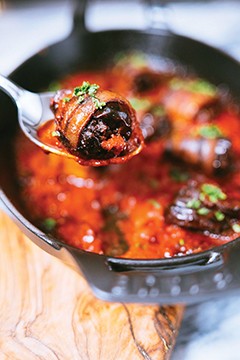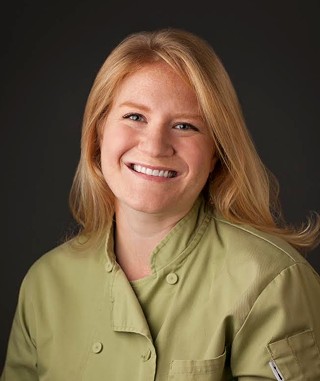Growing up, I had a wealthy, eccentric great- aunt whom I’d never met. She was a widow who lived with her eight Yorkshire Terriers in a pink mansion on the beach in Malibu. According to my grandmother, the Yorkies each had their own room and were visited regularly by a pet psychic who would convey their deepest thoughts and wants to my doting great-aunt.
I’d have questioned whether or not this marvelous woman even existed, were it not for the packages that would occasionally arrive on our doorstep. Ornate silk kites bought on a trip to Japan, bolts of fine wool from England, and every year at Christmas she would send these amazing dates, fresh and soft and stuffed with enormous walnuts.
Anything associated with Great Aunt Marcella was swathed in fantasy and fancy and, as a result, I’ve always loved dates. Unfortunately, many folks have never had a good, fresh date. Often the “dates” that are used in the Midwest are the horrid chopped, sugared variety, coated with dextrose and cellulose and tasting mainly of cardboard. Modern emphasis on “clean eating” has resulted in a resurgence in American consumption of dates recently, and whole, new crop dates are now more readily available in supermarkets.
These ancient fruits have been cultivated in the deserts of the Middle East and North Africa for more than 6,000 years. In 1898, a special department was created within the USDA called the agricultural explorers. These men traveled the world in search of new and exotic food crops that could be grown by farmers in the United States, including avocadoes, mangoes and unique varieties of citrus. It was the fruit of the date palm, however, that created the greatest sensation.
Two of the agricultural explorers, David Fairchild and Walter Swingle, studied date growing operations in Algeria. They discovered that the hot, arid conditions there were much like those in California’s Coachella Valley, often referred to as the American Sahara. Unfortunately, commercially viable dates cannot be propagated from seed, like apples, because the results are variable and not consistent. Cuttings must be taken from a parent tree, large offshoots that grow around the base of the palm and weigh up to 60 pounds.
The date palm offshoots that Fairchild and Swingle brought back to the States did so well that farmers were soon pressing for more. Brothers Paul and Wilson Popenoe, who worked for their family’s nursery outside of Coachella, traveled to the Middle East in 1911, eventually collecting 9,000 date palm offshoots and transporting them down the Persian Gulf, en route to Galveston, Texas, and finally California.
Just as California farmers were beginning to plant date groves in the desert, Americans were beginning a love affair with the Middle East, or at least with their Americanized idea of the Middle East. Blockbuster films from Hollywood like Cleopatra, The Sheik and The Queen of Sheba fanned the flames and inspired fashion, architecture and art. Preserved dates were found alongside other treasures in the tomb of Tutankhamun when it was discovered in 1922, fueling popular interest even further. California date farmers capitalized on this and used the exotic imagery of the Middle East to promote this new American crop. Date shops lined California highways and Arabian-themed date festivals, complete with camel races and scantily clad genies, were popular throughout the 1950s.
Eventually, small family date groves were sold to larger conglomerates. Media coverage of international relations during the 1970s and 80s washed away the glittering Hollywood image of harem dancers and sheiks to reveal the stark realities of oil politics and war. Some date farmers sought to distance themselves from Middle Eastern ties, while others remained tied to the horticultural history of the date and its Arabian origins.
Ninety percent of the dates grown in the Coachella Valley today are consumed here in the U.S. Medjool dates are the most widely available amongst the many varieties that are grown domestically. These include the subtly sweet Khadrawi date, cinnamon-scented Amber dates, chewy brown sugar-flavored Deglet Noor dates, and yellow Barhi dates, a delicacy which can be eaten not fully ripe and is reminiscent of a slightly astringent, crisp apple.
Dates are unique not only because of their romantic history, but also because they are so incredibly nutritious. Dates are high in fiber, as well as potassium, manganese, zinc, calcium, magnesium, copper, iron and selenium. Many Americans’ diet are deficient in these trace minerals, so dates are a delicious way to add nutrients. Dates’ high mineral content makes them a wonderful post-workout snack, perfect for refueling an active body. Dates are relatively high in calories and natural sugars, though unlike a candy bar or “energy bar” filled with junk and processed ingredients, these whole fruits deliver a hefty nutritional punch with every calorie.
In Western cooking, dates are traditionally used in baked goods. Date scones and sticky date pudding are two of my favorite sweet treats often served with a traditional English tea service. Dates also lend themselves to many savory applications, and are perfect for adding a touch of depth and sweetness to salads and stews.
I still remember the first time I had chorizo stuffed dates at Avec, a trendy late night eatery in Chicago’s West Loop. It was a typically cold and snowy Chicago evening, and my friend and I hungrily eyed the plates of food that swept past us as we waited to be seated at one of the long communal tables. We were finally seated and I immediately ordered the chorizo stuffed dates, as a friend had promised that they would change my life. The dish that arrived was as good as promised, bathed in a piquillo pepper sauce and served with crusty bread. I dream of that dish often, and even though it is easy to make at home, I still order it every time I make a trip up to the Windy City.
Chorizo Stuffed Dates a l’Avec
This is my interpretation of the recipe created by Perry Hendrix, chef de cuisine at Avec.
• 1 T. olive oil
• 6 cloves garlic, minced
• 1 large onion, minced
• 1 c. jarred roasted red peppers, with juices
• 1 can fire-roasted tomatoes, diced
• Salt and pepper to taste
• 16 large medjool dates
• ½ lb. fresh Mexican-style chorizo, casings removed
• 8 slices of bacon
• Roughly chopped flat-leaf parsley, to serve
Sauté the garlic and onion with the olive oil over medium heat. Once fragrant and translucent, about 2 minutes, add the roasted peppers and tomatoes and season to taste with salt and pepper. Simmer for about 30 minutes, until the liquid has mostly evaporated. Let cool slightly, then purée in a food processor until smooth. Add water if the sauce is too thick; you’re looking for a consistency resembling spaghetti sauce.
Heat the oven to 375 degrees. Remove the pits from the dates and stuff about 1 tablespoon of the chorizo into each date. Cut the bacon strips in half, and wrap half a piece around each stuffed date and secure with a toothpick. Bake on a parchment lined baking sheet for 18-20 minutes, until chorizo is cooked through and bacon is crisp. Serve with the pepper sauce and top with chopped parsley, alongside crusty bread.
Contact Ashley Meyer at [email protected].
A date to change your life
[
{
"name": "Air - MedRect Combo - Inline Content 1",
"component": "11490391",
"insertPoint": "3",
"requiredCountToDisplay": "1",
"parentWrapperClass": "fdn-ads-inline-content-block"
},{
"name": "Air - MedRect Combo - Inline Content 2",
"component": "11490392",
"insertPoint": "7",
"requiredCountToDisplay": "5",
"parentWrapperClass": "fdn-ads-inline-content-block"
},{
"name": "Air - MedRect Combo - Inline Content 3",
"component": "11490393",
"insertPoint": "12",
"requiredCountToDisplay": "9",
"parentWrapperClass": "fdn-ads-inline-content-block"
}
]
Illinois Times has provided readers with independent journalism for almost 50 years, from news and politics to arts and culture.
Your support will help cover the costs of editorial content published each week. Without local news organizations, we would be less informed about the issues that affect our community..
Got something to say?
Send a letter to the editor and we'll publish your feedback in print!


















